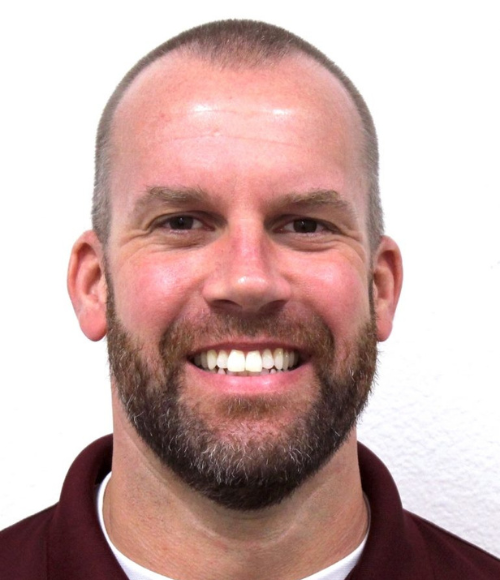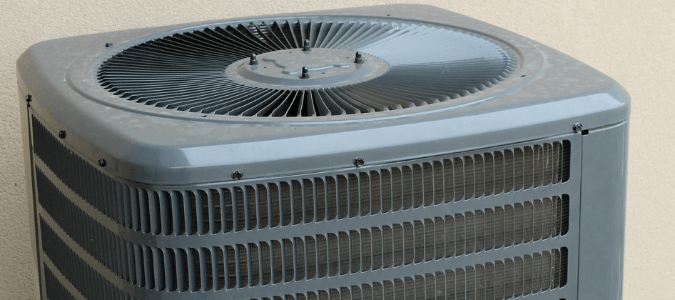
Maybe you finally bit the bullet and turned your air conditioner on, or maybe you’ve been running your AC for weeks now. Either way, to your surprise, something is not quite right. Despite hearing the sound of the AC turning on, your house is not cooling down as it used to. After some investigating, you determine that your outside AC unit isn’t running but the inside is.
Typically, this means one of two things: your outside AC hums but the fan doesn’t spin or the entire outside AC unit isn’t working at all. What could be causing either of these problems, and, more importantly, what can you do about it? In this post, we’ll go into detail about some scenarios you may run across with your air conditioner and how your components work together to create a comfortable, cool indoor living environment.

Air Conditioner Outside Unit Fan Not Working
Maybe you notice that there is warm air blowing through your vents—despite the fact that you are good about changing your AC filters and you’ve never had any type of problem like this. So, you do some investigating and realize that even though the outside unit is buzzing, the fan isn’t spinning. While this is a fairly common problem, the underlying causes are varied. Typical reasons an outside fan might stop spinning include:
- Bad capacitors
- Deficient power supply
- Contactor problems
- Burnt out motor
Bad Capacitors
When an outside fan fails, the most likely cause is a capacitor issue.
Capacitors store up the energy that powers the air conditioner’s fans. A capacitor may be used to start the fan and keep it running—as in a start/run capacitor. Some units also have dual capacitors that power you air conditioner’s fans, as well as your compressor. Like ordinary batteries, capacitors lose their energy-storing capabilities over time. These components are also subject to damage from high voltage, power surges and high temperatures.
The sweltering outdoor heat, coupled with the internal heat produced within the AC unit itself, can sometimes overwhelm a capacitor, causing it to fail. Capacitors may also go bad for several other reasons. A bad capacitor can’t properly power your AC’s fan, meaning the fan can’t spin. No air coming out of vents is a sign that you may have a bad capacitor.
Most homeowners are comfortable calling in an AC professional to troubleshoot the issue once they have a good idea of what might be going on. If you want to do all you can before doing so, there is a way to test whether a fan’s capacitor has failed. You can (carefully) try the following:
- Slide a long, slender (but strong) wooden stick through the grate shielding your air conditioner’s fan.
- Give one of the fan blades a gentle push to get it spinning.
Do not use your fingers or a conductive metal or material to spin the fan.
If, after pushing the blade, the fan takes off and continues spinning, it’s possible that the start capacitor is bad. The act of pushing the blade kickstarts the fan just like a start capacitor would.
A bad capacitor should be replaced by a professional. If an AC unit continues running with a bad capacitor, your fan motor will have to work much harder, resulting in your motor burning out completely over time. Additionally, if the capacitor is shared by the AC compressor, as in the case of a dual capacitor, your unit may experience further damage, since the compressor may overheat.
If you can’t get the fan to spin by pushing onto one of its blades, it’s also possible that:
- There is debris wrapped around the fan axle.
- The fan motor bearings are jammed or dirty.
- The fan motor itself is damaged.
Deficient Power Supply
Anything that inhibits adequate power supply to the fan assembly may cause the outside fan to stop spinning. Typically, this isn’t an easy diagnosis—you’ll need a skilled HVAC specialist to resolve this issue.
Contactor Problems
The contactor controls the fan motor. If for one reason or another, the contactor goes bad, the outside fan can stop spinning. As with many of these other AC problems, taking a DIY approach is likely to lead to added headaches and lots of time spent, whereas an experienced technician can quickly spot the problem and get your system back working.
Burnt Out Fan Motor
Too much stress may cause a fan motor to burn out. With time, the motor may also burn out due to wear and tear—especially in an AC system that isn’t properly maintained. Having regular inspections on your system may help you find and fix these types of problems early, before they lead to more extensive (and costly) repairs.
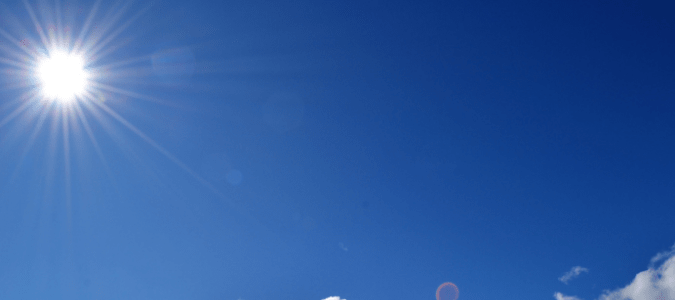
The Entire AC Unit Isn’t Working
The worst case scenario? While you are trying to determine what’s going on with your AC, you might find that in addition to the outside fans not spinning, the rest of the outside unit might also have a problem. It may, for instance, not turn on, have problems turning on or make unusual noises once it’s turned on. When you have no air coming out of your vents, you will likely need to call in a licensed HVAC professional. That being said, there are a few troubleshooting steps you can try first,
Check The Thermostat
This might seem silly, but it could be that your house feels hot because you (or someone else in your household has) inadvertently set the thermostat too warm. Other thermostat problems can result in additional temperature issues in your home as well.
What should you check? Make sure your thermostat:
- Is powered on
- Is set to cool or set to a temperature that’s at least three degrees below your current ambient temperature
You could also have a home comfort specialist check the thermostat’s wiring if you suspect that a rodent might have chewed through the wires. If the unit is battery-powered, replacing the batteries is a good first step before moving onto more time intensive and invasive measures.
Clean The Outside Unit
If the outside unit gets too dirty, your AC compressor could overheat. This could cause the unit to shut down.
Reset Button On The AC Unit Outside: What You Should Know
It’s also possible that a safety switch has locked the outside unit of your home’s AC system. If this happens to be the case, a simple reset will bring it back to normal.
Reset your system by:
- Turning off the system at the breaker or thermostat
- Waiting for one minute
- Turning the system back on
Within ten minutes, the outside unit should begin working again. If it doesn’t, the problem might be much more complex and require the help of a professional.
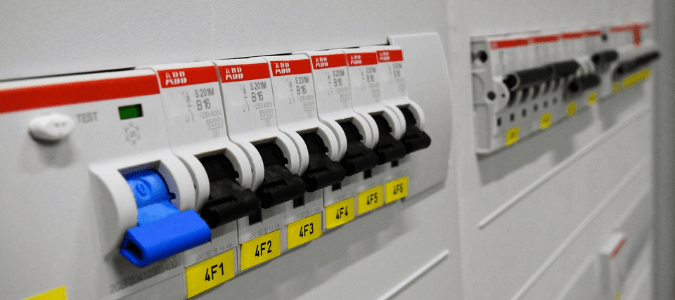
Outside AC Unit Tripping Breaker: How To Handle This Situation
Circuit breakers can get overloaded, and when they do, they trip. This is particularly common following a power surge. A tripped circuit breaker is an easy fix. You only need to move it back into place.
Look for tripped circuit breakers in the main electric panel—most homes have a circuit panel, but some older properties have a fuse box. If any breakers have been tripped, flip them to “off” and then “on”. If you have a fuse box, look for blown fuses and replace any blown fuses that you find. Some AC systems also have a fuse at the shut-off box. If this fuse gets blown, you will need to have a professional replace it.
If the breaker trips immediately after flipping it back on, you most likely have an electrical problem that requires a licensed electrician’s help. As such, you shouldn’t try to flip it back on again since doing so might cause further damage to the AC unit and other appliances in your home.
If you are determined to keep trying yourself to resolve the issue before calling in a pro, there are a few other electrical components that you could check if the outside AC unit isn’t working.
The AC Emergency/Shut-Off Switch
You may find that there’s a metal box hanging on the wall near the outside unit. Within this box is a shut-off or emergency switch. Make sure it’s in the “on” position, as someone might have accidentally left it in the “off” position.
The Indoor Unit’s Switch
This switch is often located in the attic, crawl space or a closet. It can shut off power to the indoor AC blower. If this switch is turned off, the inside AC unit may freeze, causing the entire AC system to shut down.
The AC Disconnect Box
The disconnect box is found near the outdoor unit. Sometimes the connections in there might get bumped, come loose or even burn up—such as when a breaker trips. Also, ensure that the disconnect switch is on.
The Condensate Drain Line
The drain line removes the condensation that occurs as the AC works. If this drain line is clogged, a safety switch trips and shuts down the system.
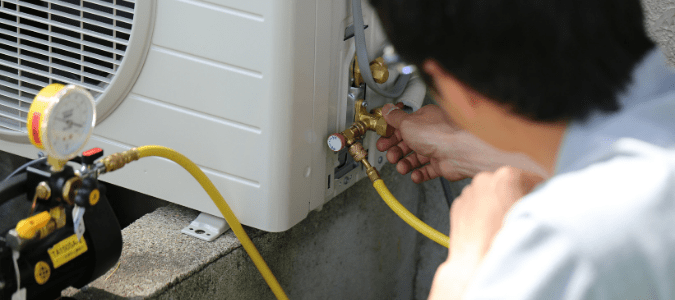
Home AC Compressor Failure Symptoms
The AC compressor is the heart of your air conditioning system. The compressor is a pump which puts the refrigerant in your AC system under extremely high pressure. In doing so, it facilitates proper refrigerant circulation within the system. If the compressor isn’t working, the rest of the system won’t work, either.
Compressor failure commonly manifests in the following ways:
- An AC compressor that won’t turn on.
- A compressor that shakes or stutters when it’s turned on, otherwise known as hard starting.
- An air conditioner that has lost its cooling capabilities or is cooling inadequately (i.e. warm or hot air is blown into the house).
- A system that keeps tripping your breaker or an outside unit that loses power frequently.
- A unit that becomes inexplicably louder than usual or one that starts producing unusual sounds, such as rumbling, rattling or clicking noises.
A broken compressor is usually a major repair. Sometimes, the only remedy to a broken compressor is to replace your entire system.
ABC Can Keep Your Home Cool And Comfortable
Dealing with air conditioning issues on your own is often overwhelming, especially since these problems often occur suddenly during peak cooling season. There are many different moving pieces and parts, and it’s hard to keep track of everything. The experts at ABC Home & Commercial Services have been helping homeowners with their heating and cooling systems for decades. We can work on any brand or model of air conditioner, and have the experience to handle even the toughest problems. With ABC’s help, you won’t have to worry about losing your cool when your AC is having problems.
